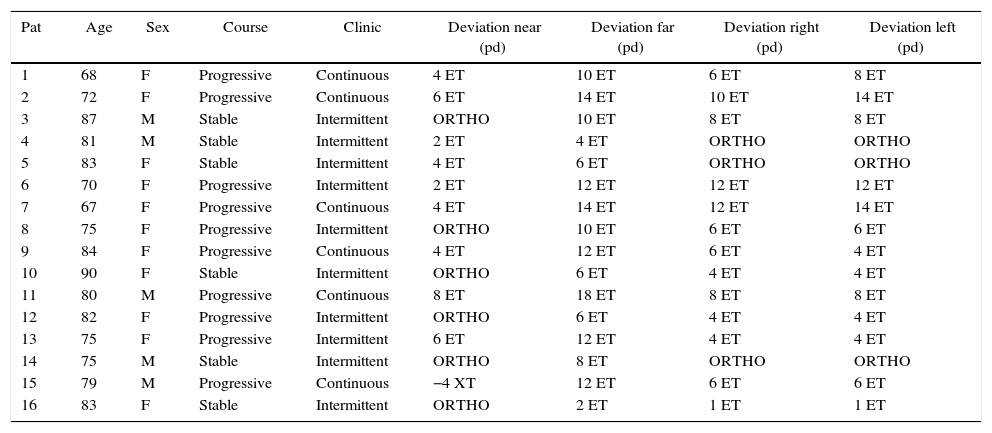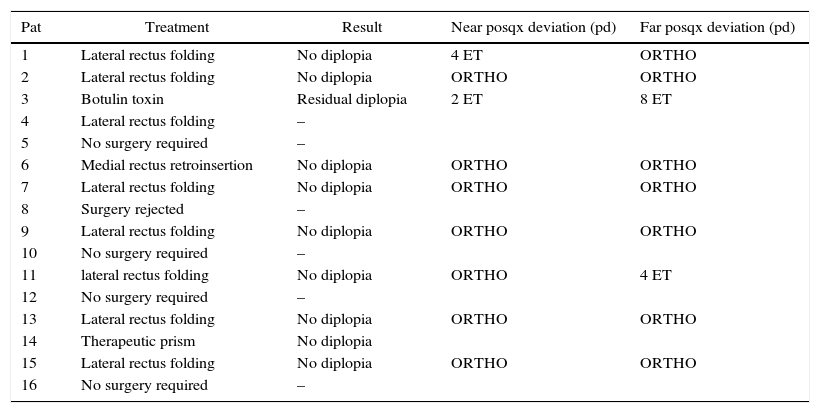To describe the clinical characteristics and surgical outcomes of a group of patients with age-related distance esotropia (ARDE).
MethodsA retrospective study was conducted on a consecutive case series of 16 adult patients diagnosed with ARDE between 2008 and 2015. The clinical features evaluated included mean age and gender, primary position deviations at distance and near, measured in prism dioptres (pd), treatment offered in each case, and post-surgical deviations. Ductions and versions were full, with no evidence of lateral rectus paresis. None of these patients had any obvious underlying neurological disorder, such as, high myopia or thyroid disease. A good result is considered to be the disappearance of diplopia in all positions of gaze.
ResultsA total of 16 patients (11 females [68.8%]) were identified. The mean age at diagnosis was 78.19±6.77 years. The mean initial esodeviation was 2.25±3.08pd at near (−4 to +8pd) and 9.5±4.18pd at distance (2–18pd). Treatment was not necessary in 5 cases because the symptoms were intermittent or well-tolerated. Of the 11 patients with symptoms, one was corrected with an external base therapeutic prism. Botulinum toxin was administered in another patient, without satisfactory results. Unilateral medial rectus muscle recession was performed on one patient, and unilateral lateral rectus plication on 7 patients, indicating prisms before surgery. One patient refused surgery despite continuous diplopia in far vision. After a mean follow-up of 16.5 months, all operated patients were asymptomatic.
ConclusionsNot all patients with ARDE require treatment, as the tolerance to diplopia varies from one subject to another. Both medial rectus weakening and lateral rectus strengthening provides excellent results.
Analizar las características clínicas de la esotropia asociada a la edad (ETAE), su tratamiento y los resultados terapéuticos obtenidos.
MétodosSe analizaron retrospectivamente expedientes de pacientes diagnosticados de ETAE entre los años 2008 y 2015. Se evaluaron edad media y sexo, desviación en posición primaria de lejos y de cerca medida en dioptrías prismáticas (dp), tratamiento realizado y desviación posquirúrgica. Ducciones y versiones eran normales, sin sospecha de limitación en la abducción. Se excluyó a pacientes con enfermedad neurológica o tiroidea y miopía magna. Se consideró un buen resultado la desaparición de la diplopía en todas las posiciones de la mirada.
ResultadosUn total de 16 expedientes fueron analizados (11 mujeres [68,8%]). La edad media al diagnóstico fue de 78,19±6,77 años. La desviación a 33cm variaba desde −4 dp de exotropia hasta 8 dp de esotropia con una desviación media de 2,25±3,08 dp de esotropia. En la mirada lejana, el rango de esotropia era de 2 a 18 dp con una desviación media de 9,75±4,18 dp. En 5 casos no fue necesario tratamiento por ser la sintomatología intermitente y bien tolerada. De 11 pacientes sintomáticos, uno fue corregido con prisma. Se administró toxina botulínica en otro paciente sin resultado satisfactorio. Otros 7 fueron intervenidos mediante plegamiento de recto lateral y uno mediante retroinserción de recto medio, al que se le indicaron prismas antes de la intervención. Un paciente rechazó la cirugía a pesar de la diplopía constante en visión lejana. A los 16,5 meses de media de evolución, todos los pacientes intervenidos quirúrgicamente se encontraban asintomáticos.
ConclusionesNo todos los pacientes con ETAE requieren tratamiento, pues la tolerancia a la diplopía es variable de unos sujetos a otros. El debilitamiento del recto medial o el refuerzo del recto lateral proporcionan excelentes resultados.









